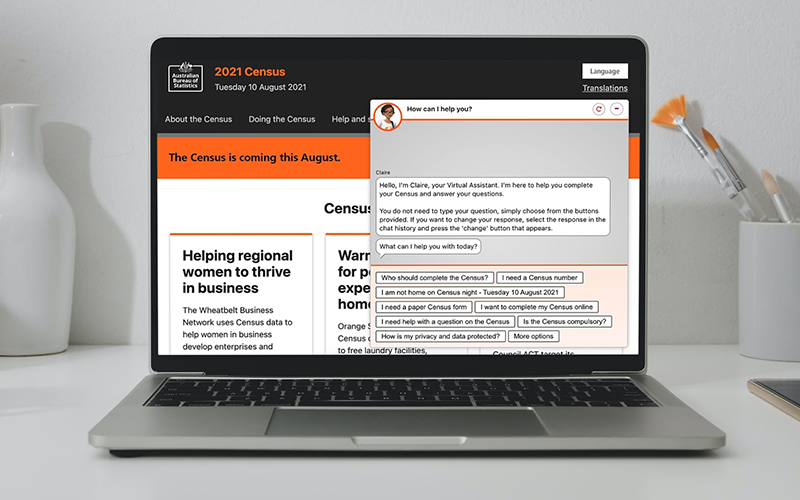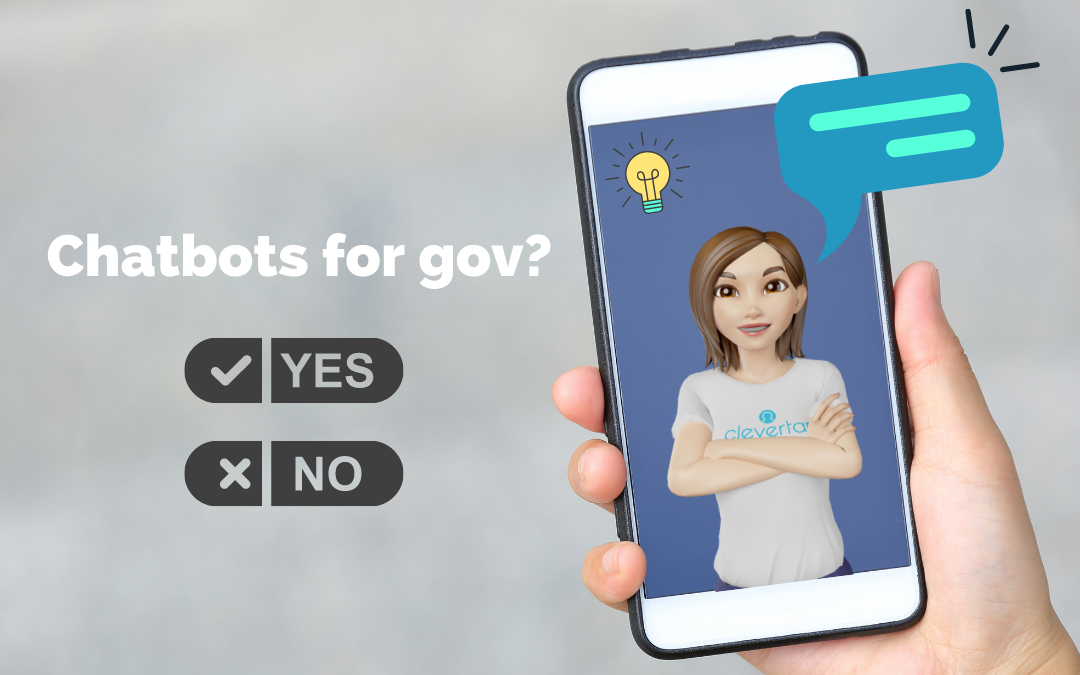In the past three years, we’ve created and launched a number of chatbots to help government agencies provide timely and accurate responses to Australians.
Remember Zoe? She lives on SA Health’s website and was built and deployed in six days to answer questions about COVID-19. What about Claire who supported Australians to complete the Census? Then there was Andie, who helps teachers that apply for job vacancies within the Department for Education SA navigate the process.
Who could forget Elana, a chatbot that lived on the South Australian government’s entry link website helping people understand border entry requirements to South Australia.
Collectively, they answered thousands of questions from the public and helped the government respond to surges in enquiries during the pandemic and the Census.
We’ve seen first-hand how chatbots can make a real difference in helping people get information they need, and our prediction is that we’ll see more governments using these tools in 2022 and beyond. Why? Because we’re seeing a major shift in the way customers engage with all service providers, particularly the government.
We are living in a digital world, and as such most taxpayers and ratepayers expect their government to be just as present and available on the internet. It has become normal for people to expect most government interactions to be in conversation with a chatbot or via live chat. As the pandemic has accelerated even more online activities and interactions, we’ve really embraced being digital natives: we want timely and accurate responses to our questions, and we want them now.


This strong consumer preference for online self-service options makes sense. Asking a chatbot a question or using live chat is just easier than phoning a government agency or visiting your local council – not to mention more efficient! The shift towards online self services has been rapid as customers grow increasingly frustrated waiting around.
Governments around the world are investing in chatbots(1) to help them provide more timely and accurate information, as well as improve customer satisfaction levels. In some countries this is also about providing better access to those who can’t easily visit a service centre or reach out over the phone.
But do all government agencies and all levels of government need a chatbot in 2022? What about the 537 councils Australia wide, do they need a chatbot? What about the MP offices, government agencies and departments?
With a new year upon us and customer expectations changing all the time, we asked some experts in this space:
Why do governments need a chatbot in 2022?
Will they become a standard feature in government communication as a way to provide fast and accurate information?
Keep reading to find out.
Martin Luerssen, Chief Technology Officer, Clevertar
“Chatbots have long been hailed as the next big thing in customer service because they’re able to handle a large number of customer interactions at once. Our work with government agencies in South Australia and the Australian Bureau of Statistics is proof that chatbots can be highly effective in automating self-service pathways and reducing call volumes. Not to mention, it can facilitate internal efficiencies and allow staff to focus on more complex queries. In 2022, it could be argued that government agencies should be ensuring information is accessible 24/7 and therefore most government agencies that are consumer-facing should consider implementing a chatbot”.
Teresa Dickinson, Senior Responsible Officer for the 2021 Census, Australian Bureau of Statistics (ABS).
Teresa Dickinson, Senior Responsible Officer for the 2021 Census has reflected on the important role Claire, the Census chatbot, played in the ABS’s customer service strategy:
“The ABS recognised and understood the need to provide people with information about the Census in the individual’s channel of choice. The addition of self-service features like Claire, the chatbot, helped the ABS to ensure that people had easy access to the information they needed to complete the Census”.
Sharon Melamed, Founder and Managing Director of Matchboard
“Government agencies need chatbots to communicate with their ratepayers/taxpayers in 2022 because there is an acute shortage of labour in the customer service industry. There are simply not enough humans in Australia willing to work in a contact centre environment, answering customer inquiries by phone, chat and email. Chatbots, as an automated solution, can fill this gap as “digital workers”, answering the simple questions or triaging inquiries. Secondly, consumers want answers quickly and chatbots can provide instant responses – there is no need to wait in a queue on hold. Thirdly, young people would rather clean a toilet than call a call centre. Chatbots therefore cater to the digital self-service preference of millennial users.”
“Young people would rather clean a toilet than call a call centre. Chatbots therefore cater to the digital self-service preference of millennial users.”
Michael Metcalfe, founder of Kynd
People demand simple, fast, and ‘one interaction’ style solutions from government agencies. Chatbots provide this with responses tailored to their personal needs. Combining this with advancements in AI and scenario learning, chatbots can significantly decrease costs for governments, while improving service for taxpayers. It’s win-win and will certainly become mainstream.
Greg Eyre, Vice President, ANZ, Blue Prism
Governments should use chatbots and other AI technology to accomplish more within tight budgets, quicker timeframes and to enhance customer experience. While chatbots can quickly answer FAQs and point customers in the right direction, intelligent automation (IA) can automate the repetitive and tedious tasks that sit behind the chatbot. With intelligent chatbots councils will free up employee time, enabling them to focus on more rewarding tasks, and service customers better.
“With intelligent chatbots councils will free up employee time, enabling them to focus on more rewarding tasks, and service customers better.”
Salvador Ordorica, The Spanish Group
Governments are obliged to maintain service capacities that may be used only once a year or even once every few years. All of this might be changed by chatbots. Chatbots are an economical and dependable customer service solution for various services after they’ve been introduced.
Explore AI with us
It’s never too soon or too late to explore the world of artificial intelligence!
We’re keen to discuss how your business’ everyday problems could be solved with AI, and how they might positively impact your customers.
Please leave a message and we’ll get back to you soon.

